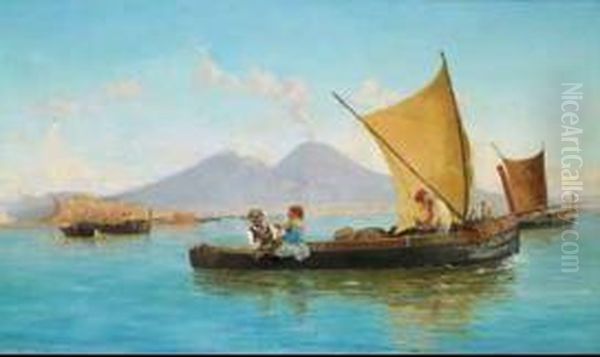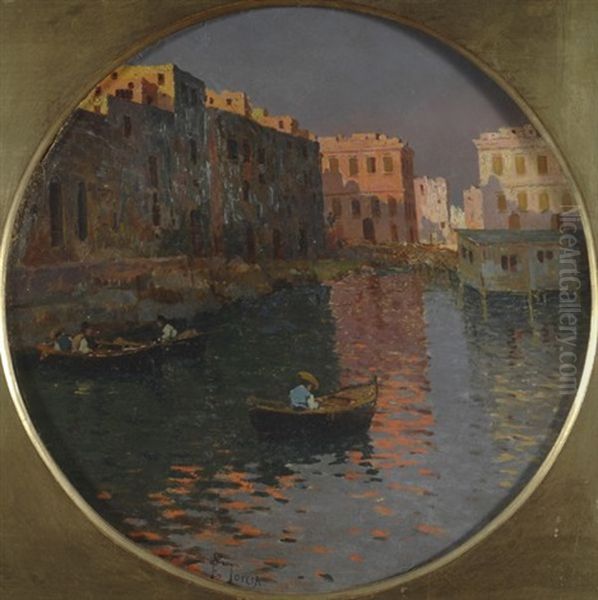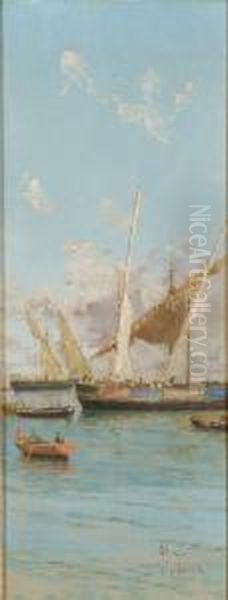Francesco Saverio Torcia (1840-1891) was an Italian painter hailing from the vibrant city of Naples. Active during a transformative period in Italian art, Torcia dedicated his career to capturing the landscapes, maritime scenes, and everyday life of his native region. Though perhaps not as globally renowned as some of his contemporaries, his work offers a valuable window into the artistic currents of 19th-century Naples, particularly its strong tradition of Realism and Naturalism. His paintings, predominantly in oils, reflect a keen observation of his environment, a sensitivity to light, and a dedication to depicting the authentic character of Southern Italy.
The Artistic Crucible of 19th-Century Naples
Naples in the 19th century was a bustling metropolis and a significant cultural hub, attracting artists from across Italy and Europe. Its stunning natural beauty, from the dramatic silhouette of Mount Vesuvius to the sparkling Bay of Naples, had long made it a favored destination for painters, especially those undertaking the Grand Tour. This tradition of landscape painting was deeply ingrained in the city's artistic identity.
The Royal Academy of Fine Arts in Naples (Reale Accademia di Belle Arti di Napoli) played a crucial role in shaping generations of artists. However, the 19th century also saw movements that sought to break free from purely academic constraints, embracing more direct and truthful representations of the world. Artists began to look increasingly to their immediate surroundings for inspiration, moving away from purely historical or mythological subjects that had dominated earlier periods. This shift laid the groundwork for the styles that Francesco Saverio Torcia would come to embrace.
The Rise of Realism and Naturalism in Italy
Throughout Europe, the mid-19th century witnessed the ascent of Realism as a dominant artistic force, and Italy was no exception. Realism sought to depict subjects truthfully, without artificiality and avoiding exotic or supernatural elements. It often focused on the everyday lives of ordinary people, landscapes as they truly appeared, and contemporary social realities. This was a reaction against the idealized forms of Neoclassicism and the emotional drama of Romanticism.

In Italy, this trend manifested in various regional schools and movements. Perhaps the most famous were the Macchiaioli in Tuscany, including artists like Giovanni Fattori, Telemaco Signorini, and Silvestro Lega. They utilized "macchie" (patches or spots of color) to capture the immediate effects of light and shadow, often working en plein air (outdoors). While distinct, their commitment to realism and direct observation resonated with similar developments in other parts of Italy, including Naples. Naturalism, a related but often more scientifically-minded approach, also gained traction, emphasizing an almost documentary-style depiction of subjects.
The Neapolitan Landscape Tradition: The School of Posillipo
One of the most significant local influences on Neapolitan painters like Torcia was the School of Posillipo (Scuola di Posillipo). Flourishing from the 1820s to the 1850s and beyond, this group of landscape painters was pivotal in popularizing small-scale, open-air oil sketches and watercolors that captured the picturesque scenery around Naples.
The Dutch artist Anton Sminck van Pitloo is often considered the founder of this school. He encouraged his students to paint directly from nature, emphasizing spontaneity and the accurate depiction of atmospheric conditions. Key figures associated with the Posillipo School include Giacinto Gigante, Gabriele Smargiassi, and Consalvo Carelli. Their works, often intimate and luminous, celebrated the local views, coastal scenes, and the unique light of Southern Italy. While Torcia's active period was somewhat later, the legacy of the Posillipo School, with its emphasis on local scenery and natural light, undoubtedly formed part of the artistic atmosphere in which he developed. His choice of subjects, such as views of Vesuvius and maritime scenes, aligns closely with the thematic concerns of this influential Neapolitan tradition.
The Scuola di Resina: A Focus on Vernacular Realism
Emerging slightly later, around the 1860s, was the Scuola di Resina (sometimes referred to as the Republic of Portici), a group of painters who gathered in Resina, a town at the foot of Mount Vesuvius. These artists, including Marco De Gregorio, Federico Rossano, and the young Giuseppe De Nittis (before he achieved international fame in Paris), were more explicitly aligned with the broader European Realist movement. They sought to depict the unvarnished reality of rural and working-class life, often with a somber palette and a focus on social observation. Adriano Cecioni, a sculptor and painter also associated with the Macchiaioli, was another important figure connected to this group.

The Scuola di Resina represented a more rugged, less idealized approach compared to some of the more picturesque tendencies of the Posillipo School. Their commitment to portraying everyday existence, including the hardships and simple dignity of common folk, marked an important step in Neapolitan Realism. Torcia's genre scenes, such as those depicting fishermen, would have found resonance with the thematic interests of the Resina artists, even if his style might have retained a more luminous quality.
Francesco Saverio Torcia: Life and Oeuvre
Born in Naples in 1840, Francesco Saverio Torcia lived and worked in his native city until his death in 1891. This places him squarely in the latter half of the 19th century, a period when the aforementioned artistic trends were well-established and evolving. Information about his formal training is not extensively detailed in readily available sources, but it is highly probable that he would have been exposed to the teachings of the Naples Academy and certainly to the work of the prominent Neapolitan painters of his day.
His primary medium was oil paint, a versatile medium well-suited to capturing both the subtle nuances of light in a landscape and the textural details of a genre scene. His works are characterized by their commitment to realistic depiction, a careful handling of color, and an ability to convey the specific atmosphere of the Neapolitan environment.
Key Themes and Representative Works of Torcia
Francesco Saverio Torcia's body of work, as evidenced by auction records and art historical mentions, centers on themes close to his Neapolitan heart: the sea, the iconic presence of Vesuvius, and the daily lives of the local populace, particularly those connected to maritime professions.
Il ritorno dalla pesca (The Return from Fishing) is one of his notable works. This painting likely depicts fishermen bringing in their catch, a common sight along the Neapolitan coast. Such a scene would have allowed Torcia to explore various artistic elements: the human figure in motion, the textures of boats and nets, the play of light on water, and the social reality of a vital local industry. The title itself suggests a narrative moment, capturing the end of a day's labor, potentially imbued with a sense of quiet dignity or exhaustion. This theme aligns with the broader Realist interest in depicting everyday work and life.

Barche davanti al Vesuvio (Boats in Front of Vesuvius) and the similarly titled Boats in Front of Vesuvius highlight another quintessential Neapolitan subject. Mount Vesuvius, ever-present and majestic, served as a dramatic backdrop for countless artists. Torcia's interpretations would have focused on the interplay between the formidable volcano and the human activity in the foreground – the boats suggesting commerce, fishing, or leisure. These works would have allowed for explorations of scale, atmospheric perspective, and the unique light conditions of the Bay of Naples.
Marina con barche (Seascape with Boats or Harbor with Boats) is another title indicative of his focus. Marine painting has a long and distinguished history, and for a Neapolitan artist, the sea was an inescapable and endlessly inspiring subject. These works could range from tranquil harbor scenes to more dynamic depictions of boats on open water, offering opportunities to study wave patterns, reflections, and the varied forms of maritime vessels.
Tramontana sul canale (North Wind on the Canal) or the possibly related TRAMONTO SUL CANALE (Sunset on the Canal) suggest a focus on specific atmospheric conditions or times of day. "Tramontana" refers to a northern wind, often cool and brisk, which would create a particular mood and visual effect on the water and surrounding landscape. A "Tramonto" (sunset) scene would, of course, be an opportunity to explore the rich and fleeting colors of the evening sky and their reflection on the canal's surface. Such paintings underscore an interest in capturing transient moments and the impact of natural phenomena on the visual appearance of a scene, a hallmark of much 19th-century landscape painting.
The work titled PESTACCESI is also listed among his oeuvre, though without further contextual information or visual reference, it is difficult to elaborate on its specific subject matter or style. However, its inclusion in records of his work confirms its existence as part of his artistic output.
Collectively, these titles paint a picture of an artist deeply engaged with his local environment, skilled in depicting both grand natural features and intimate human activities. His style, rooted in Realism, would have emphasized accurate observation and a faithful rendering of light and color.
Torcia and His Contemporaries: A Shared Artistic Milieu
Francesco Saverio Torcia worked during a period rich with artistic talent in Naples and across Italy. While direct collaborations or documented rivalries are not specified in the available information, he would have been aware of, and likely influenced by, the leading figures of his time.
The towering figures of Neapolitan painting in the latter 19th century included Domenico Morelli and Filippo Palizzi. Morelli was known for his historical and romantic paintings, often with a dramatic flair and rich color. Palizzi, on the other hand, was a staunch Realist, particularly renowned for his depictions of animals and rural life, and he played an influential role at the Naples Academy, advocating for the study of nature. Torcia's commitment to realism, especially in genre scenes, would have found common ground with Palizzi's principles.
Other notable Neapolitan painters whose careers overlapped with Torcia's include Gioacchino Toma, known for his poignant and often melancholic genre scenes depicting domestic life and social issues. His introspective and carefully rendered works represent another facet of Neapolitan Realism. Antonio Mancini, though his most innovative work came slightly later and pushed towards a more expressive, almost proto-Impressionistic style, also emerged from the Neapolitan environment.
Beyond Naples, the influence of the Macchiaioli, such as Giovanni Fattori with his depictions of military life and Tuscan landscapes, and Telemaco Signorini with his urban scenes and sharp social observations, contributed to the broader Italian Realist movement. While geographically distinct, the shared pursuit of truth in representation created a common artistic language across the peninsula. Artists like Giuseppe De Nittis, who, after his early association with the Scuola di Resina, achieved great success in Paris with his elegant cityscapes, demonstrated how Italian artists were engaging with international trends.
One could also consider painters like Federico Rossano, who, like Torcia, often depicted coastal scenes and landscapes with a strong sense of place, or Francesco Paolo Michetti, from the Abruzzo region, whose vibrant and often large-scale depictions of local customs and peasant life also embodied a powerful regional Realism. The Venetian painter Giacomo Favretto similarly captured the everyday life of his city with charm and vivacity. Torcia's work, therefore, can be seen as part of this wider Italian artistic current that valued direct observation and the depiction of local character and scenery.
Exhibitions, Recognition, and Legacy
The available information indicates that Francesco Saverio Torcia's works have appeared in various art market contexts, including auctions and gallery exhibitions. For instance, his paintings have been featured at events organized by Pandolfini Casa d'Aste, such as the "Pandolfini Arcade 2024-2024 100th Anniversary" exhibition held at Palazzo Ramirez Montalvo in Florence. This suggests a posthumous recognition and continued interest in his work among collectors. Pananti CASA d'ASTE has also handled his works, including pieces like TRAMONTO SUL CANALE and PESTACCESI.
His paintings have been included in thematic auctions such as "DIPINTI DEL XIX SECOLO" (19th Century Paintings) and "ARREDI, DIPINTI ANTICHI DIPINTI DEL XIX SECOLO" (Furnishings, Old Master Paintings, 19th Century Paintings). The fact that his works, such as Il ritorno dalla pesca (estimated at €10,000-€12,000 at one point) and Marina con barche (estimated at €3,400-€4,500), command respectable prices in the art market speaks to their perceived quality and appeal.
While Torcia may not have achieved the same level of fame as the absolute titans of 19th-century Italian art, his consistent presence in the art market indicates a durable, albeit perhaps more specialized, appreciation. He represents a significant cohort of skilled painters who diligently documented their time and place, contributing to the rich tapestry of regional Italian art. His legacy lies in his authentic portrayal of Neapolitan life and landscapes, providing valuable visual records imbued with artistic sensitivity.
The Enduring Appeal of Neapolitan Scenes
The subjects chosen by Francesco Saverio Torcia—the Bay of Naples, the ever-watchful Vesuvius, the bustling fishing communities—have held an enduring fascination for both Italians and international audiences for centuries. These scenes are not merely picturesque; they are laden with history, culture, and a unique sense of vitality. The brilliant Mediterranean light, the azure waters, and the vibrant street life offered endless inspiration.
Torcia, by focusing on these elements, tapped into a deep well of artistic tradition while simultaneously offering his personal, Realist interpretation. His paintings contribute to a vast visual archive that celebrates the distinct character of Naples and its environs. For viewers today, his works offer a glimpse into a 19th-century world, capturing moments of daily existence and the timeless beauty of the Neapolitan landscape. His dedication to these themes ensures his place within the lineage of artists who have sought to define and celebrate this remarkable corner of Italy.
Conclusion: A Painter of His Time and Place
Francesco Saverio Torcia stands as a competent and dedicated artist of 19th-century Naples. Rooted in the traditions of Realism and Naturalism, he skillfully translated the world around him onto canvas. His depictions of maritime life, iconic landscapes featuring Vesuvius, and atmospheric canal scenes reveal an artist attuned to the nuances of his environment and the character of its people.
While perhaps not a revolutionary figure who dramatically altered the course of art history, Torcia was a significant contributor to the Neapolitan school of painting. He worked alongside and in the wake of influential movements like the School of Posillipo and the Scuola di Resina, absorbing their lessons while forging his own modest but authentic path. His paintings, still appreciated and collected today, serve as a testament to his skill and offer a valuable visual record of Neapolitan life and scenery during a vibrant period of Italian art. Francesco Saverio Torcia remains a noteworthy representative of the many talented artists who chronicled the beauty and reality of 19th-century Italy.